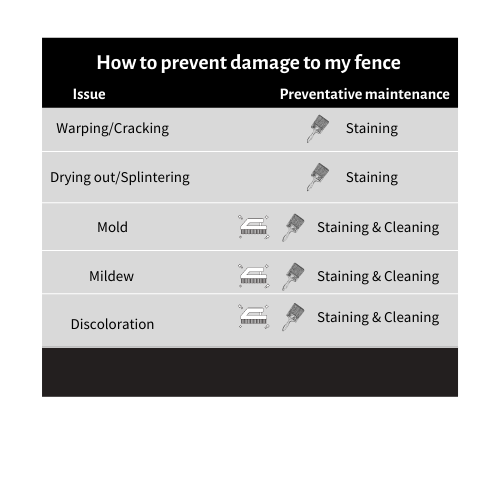Not all fences are the same, so there may be a few problems you encounter with your fence versus another homeowner. However, it is good to be aware of all the common types of cedar fence damage, especially when investing in a new fence. The most common problems found with a cedar fence are:
- Rotting boards
- Leaning and sagging
- Discoloration
- Warping/cracking
- Bleeding

Rotting fence boards

Because cedar is an organic material, it is prone to rotting. Fortunately, there are steps you can take to prevent rot on your cedar fence.
- Consistently stain your fence every 3-5 years. This will help seal out moisture and preserve the integrity of your fence.
- Keep plants away from the fence. Plants will strip away nutrients from the wood that are necessary. There are a few effects from this; for instance, it will age it faster.
Excess dirt near a cedar fence will also cause rot. Excess water will also begin the aging and rotting process, so keeping the fence away from constant water streams will extend your fences lifespan. Though it is unrealistic to keep a fence dry all the time, especially in the pacific northwest, keeping sprinklers away from the wood will be a big help. If you notice a board does begin to rot, make sure to replace it as soon as possible. Otherwise, it may harm the integrity of the fence. Clean off any moss and mildew on the fence in order to preserve it.
Leaning and sagging
Your fence should not be sagging, especially if it has not exceeded its predicted lifespan. If it is, there are few possible reasons for the leaning or sagging.
- There is decay or rot somewhere on the fence that is ruining its structural integrity. The best way to prevent this, aside from what is mentioned above to prevent rotting, is to build your fence with a high-quality wood. At Cascade, our wood fences are made of cedar, which is what we would recommend building your fence with.
- Weather could have also caused the lean. Even an expertly crafted and installed fence can suffer from weather damage. In the case of leaning, it is most likely that the soil was loosened around the fence. Adding sister rails can help stabilize the fence. Adding in steel posts, rather than wood posts, will also help your fence avoid sagging.
Cedar fence discoloration
Discoloration is a common problem for wood and cedar fences, especially in wet places like the Portland area. Two common causes for a fence to turn grey:
- The sun- UV rays strip color from the outer layer of wood
- Rain- especially in the Pacific Northwest, where there is an excess of rain, the water can cause rot on your fence
These can turn your cedar fence into an unappealing grey color. Once your fence turns grey, fear not- there is a solution. First, pressure wash the fence to get rid of the dirt and debris and to take off the mold that is causing the fence to be discolored. Second, do a deep clean of your fence.
Warping/cracking
All wood is porous, and expands when it soaks in water and shrinks when it dries. Although pressure treated wood helps prevent this, it is still susceptible. This expanding and shrinking can caused the wood to become warped or even create small cracks. To prevent this, perform annual maintenance on your fence.
“Bleeding”
Bleeding- or streaks of discoloration- is an issue with cedar fences that have the improper fastener installed. The metal reacts with the surface of the wood and leaves undesirable streaking. To prevent this, make sure that galvanized or stainless steel fasteners are installed. Here at Cascade, we use Aluminum screw shank nails to prevent any bleeding.
Most of these issues listed can be prevented, but quite a few are difficult to fix. A high quality fence will help make sure that your fence will last, and consistently maintaining the fence will help it last even longer. Many of these issues arise with poor quality workmanship or from a lack of upkeep on the fence.

